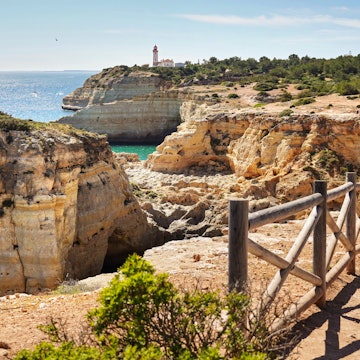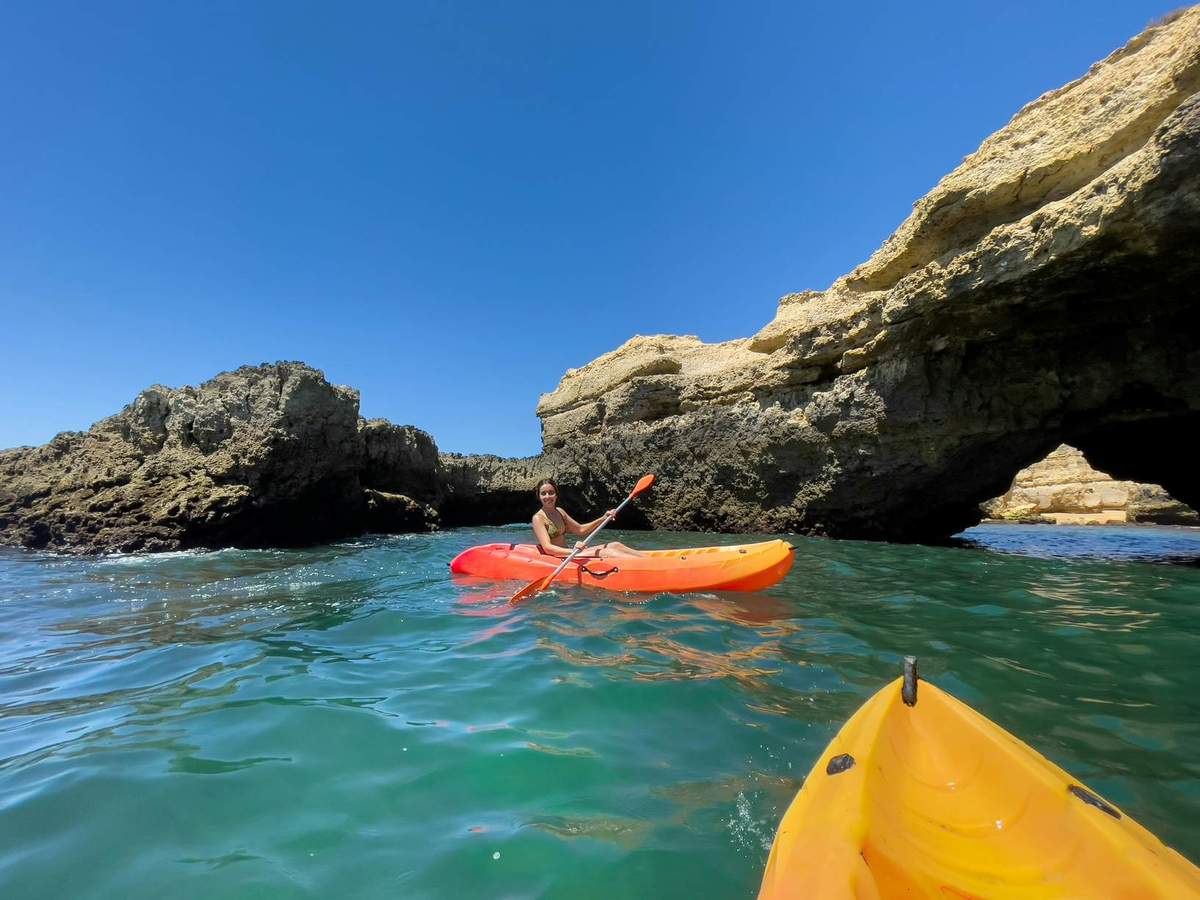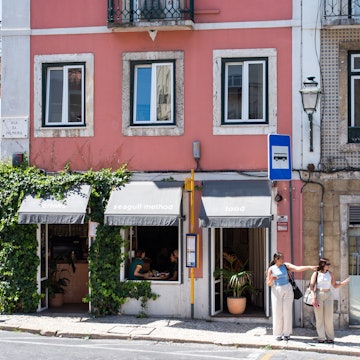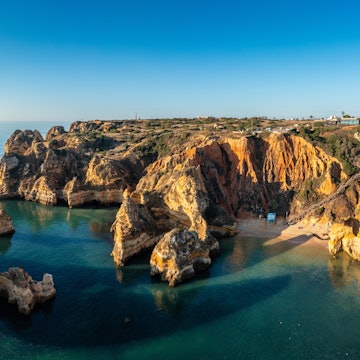

Ponta da Piedade in Lagos, in the Algarve region of Portugal. Marco Bottigelli/Getty Images
The Algarve’s spectacular scenery is guaranteed to make your heart sing and keep your purse happy. You don’t need to spend a cent to wander around whitewashed pretty villages like Ferragudo, lounge on award-winning golden beaches, or relish the sunset from cliff-topping trails.
Add in a handful of free-to-access nature reserves, no-cost museums (even ticketed exhibitions seldom cost more than a couple of euros) and a packed-out cultural calendar of complimentary events, and you have a ready-made vacation that won’t break the bank. Here’s our pick of the best free experiences in Portugal’s southern coastal playground.
1. Swap costly Benagil Cave for the Seven Hanging Valleys Trail
Since becoming one of the Algarve’s top attractions, the sky-lit, cavernous Benagil Cave has become crowded and costly. For an equally impressive but onland experience, bypass the boats and take in the craggy coastline around Carvoeiro along the Seven Hanging Valleys Trail. The 6km (3.7 miles) linear trail connects the striking rock formations of Praia da Marinha with Vale de Centeanes on a rugged, cliff-topping route that dips and climbs between secluded sandy coves and sensational views. You’ll still have the chance to glance inside the caves from behind erosion-protecting barriers.
Local tip: In 2024, new regulations were introduced at Benagil Cave. Guides are now mandatory for all visits (non-guided kayak rentals and swimming are also prohibited), and breaches are punishable by a fine. So a solo attempt might seem like a money saver, but it can end up costing far more than joining a kayak tour.

2. Celebrate local culture at first-class free festivals
No matter the season, the Algarve knows how to celebrate – and many of the region's biggest festivities are complimentary. Blow off the winter blues at Loulé’s colorful Carnival street parades, celebrate summer at Carvoeiro’s thousands-strong Black and White Night beach party, snack and sing along to live bands at Portimão's Sardine Festival, or close out the year at Albufeira's NYE beach bash. There are numerous smaller cultural events year round; check the regional event calendar so you don't miss out.
3. Witness ancestral handicrafts at Loulé Criativo’s workshops
The inland town of Loulé still retains a more gentle, traditional Algarvian feel. Best known for its personality-packed neo-Moorish market – especially on Saturdays when the Algarve’s largest mercado spills outside – it’s a terrific place to purchase and learn about local produce and souvenirs. For more insights, tour Loulé Criativo’s network of six traditional workshops, created to preserve ancestral crafts. Unlike the busy, working market, these gratis studio-cum-musueum spaces are designed to showcase handicrafts at work, and questions are encouraged. Witness copper being beaten into the region’s cataplana cooking pots, admire centuries-old palm tree weaving techniques, and observe Moorish-era pottery being spun. There’s no obligation to buy, though these authentic items make excellent gifts.
Local tip: Previously, many municipal museums in the Algarve offered free admission on Sundays, a discount now reserved for residents. Luckily, some of Loulé’s museums remain free every opening day, including the Islamic Baths archaeological site. Even the main museum, including part of the castle walls, costs only €1.62 (US$1.85); children under 13, adults 65 and older, and students enter for free.
4. Beach-hop along the boardwalk to panoramic Ponta da Piedade
Unlike in other parts of Portugal, the Algarve’s passadicos (boardwalks) are all free to access. You’ll encounter them crossing dune beaches, craggy cliffs, and in the mountains, but few compare to the wooden walkways linking Lagos and the Ponta da Piedade headland. Along the way, staircases descend to some of the Algarve’s prettiest pint-size, cliff-backed bays such as Praia do Camilo and Praia Dona Ana, though the viewing platform overlooking the sandstone sea stacks steals the show. Climb down the ponta’s rock-chiseled staircase for a closer, wave-splashed inspection, and you’ll have a sense of what boat trips into the caves feel like.
Local tip: All beaches in the Algarve are free to access, but renting a parasol and sun loungers from concessions typically costs around €15 (US$17) per day for two. Save by asking if your accommodation has a parasol you can bring to the beach, or rent one in town for the week.

5. Spot flamingos in the Ria Formosa’s wetlands
Blending barrier islands, wetlands and salinas (salt pans), the vast Parque Natural da Ria Formosa provides a haven for migratory birds, purple swamphen (the park’s symbol) and flamingos, some of which have now nested year-round. Entry to the park’s headquarters and environmental center, Quinta de Marim, is ticketed. But amble around the salinas in Tavira or Olhão, or the Passadiços de Loulé boardwalk behind Faro’s beach lagoon, and chances are high you’ll spot a flamboyance for free.
Local tip: Faro and Tavira aren’t the only birding highlights. If you’re staying in the west, save on transport costs by visiting the boardwalk bird blinds around Ria de Alvor Nature Reserve, or in the east, the salinas in mainland Portugal's oldest nature reserve.
6. Reach Ilha de Tavira on foot to save on the ferry fare
Separating the Ria Formosa’s lagoon from the Atlantic are a handful of swoon-worthy barrier islands, ideal for a day of sun, sea and sand. Inexpensive ferries link them all with the mainland. However, it’s possible to access Ilha de Tavira for free by crossing the bridge just west of Santa Luzia and following the picturesque pathway adjacent to the mini train. After 1.5km (1 mile), you’ll arrive at Praia do Barril’s far-reaching sands and anchor cemetery, honoring the extinct tuna fishing industry. Praia de Faro, technically a peninsula beach rather than an island, can also be reached by bike or bus.
Local tip: Depending on where you’re staying, it can be cheaper to take one of the affordable and scenic island ferries from Olhão (from €2.30/US$2.63 one-way) to the Ria Formosa’s other islands than the bus to Praia do Barril’s walkway. Olhão’s excellent waterfront market is ideal for crafting a picnic, or do as the locals do and buy a bola de Berlim (custard-filled doughnuts) from the traditional summer beach sellers as a post-swim snack.

7. Peer into an elegant palace from the public section of Estoi’s gardens
Slightly inland from Faro, the typically Algarvian village of Estoi has the elegant, 18th-century Palácio de Estoi, adorned with Baroque, Rococo, and neo-Moorish flourishes. Previously, non-guests could visit the palace-turned-hotel and its well-manicured gardens for free, but now there is an entrance fee. To enjoy a no-cost peek into the palace’s grounds embellished with stained glass, azulejos (blue and white painted tiles) and statues, enter the lower gardens via the green entrance gate on the village’s main square. Climb the stairs to glance at the upper gardens through the fence before settling under an orange tree for a refined picnic.
Local tip: On Sundays, public access is closed, and visits are only by paying the hotel’s €5 (US$5.70) entrance fee. Better value is the nearby €2 (US$2.28) Milreu Ruins, a vast open-air, mosaic-decorated Roman villa.
8. Contemplate the roar of the Atlantic at Cabo de São Vicente
Sagres, on the Algarve’s westernmost tip, is the place of seafaring legends. Dominating the laid-back surfing town’s headland is the foreboding Fortaleza de Sagres, a 15th-century military structure that houses an “Age of Discovery” exhibition center. To save on the €10 (US$11.42) ticket, skip Sagres’ fort and take in the ocean-chiselled cliffs and never-ending Atlantic from the Cabo de São Vicente headland instead. With a regularly fierce salty breeze and bellowing waves, Europe’s lighthouse-crowned southwesternmost point is one of those places you can lose yourself in reflection. Or sip a cold supermarket beer at sunset.
9. Roam the Costa Vicentina’s cliffs, beaches and ancient sights
For a foot-forward, low-cost vacation, nothing beats the west coast’s Fishermen’s Trail, a 13-section multiday trek between the Costa Vicentina’s wild, dune-ribboned surf beaches, craggy cliffs and Moorish ruins. Pick a one-day section, pack a picnic, and you’ve got a practically free day out, all set against some of Europe’s most impressive coastal panoramas. Paddle on river-wrapped Praia de Odeceixe, poke around inside the walls of Aljezur’s Moorish castle, find the dinosaur footprints fossilized on Salema’s beach rocks, or walk the Pontal da Carrapateira Trail for a well-rounded, beach-hopping overview.
Local tip: If you’re relying on public transport to reduce costs, the southern sections are much better connected; buses along the west coast are limited. Vamus line 47 has multiple daily connections from Lagos to Vila do Bispo, from where you can hike the mostly coastal 20km (12.5 miles) Section 10 to Sagres for a return bus.

10. Tour Tavira’s no-charge churches and historic sights
Faro’s Vila-Adentro (Inner Old Town) might seem the most obvious spot for a free city walking tour, but a self-guided stroll around Tavira’s bougainvillea-adorned backstreet and colorful doors is subjectively more photogenic. There’s a cluster of free historical sights in the river-flanking town, including the crowning Moorish castle, a small and fenced Phoenician excavation site, a reconstructed Roman bridge, and, beyond the salinas, the tuna fishing museum. Still, Tavira is most famous for its 30-odd churches. The larger edifices charge an entry fee (there’s a combined ticket), but smaller chapels such as Ermida de São Sebastião – which features a remarkable hand-painted ceiling – are free.
Local tip: Some of the excavations of the 12-century Almohad Quarter are hidden inside the Convento Da Graça (now a hotel). It’s free to enter, although non-guests technically should email in advance; however, the receptionist often allows last-minute access.
11. Splash around in pretty Alte’s fontes and falls
Waterparks are pricey, but waterfalls are free. You’ll find a couple of cascade-fed swimming holes around the region, such as Pego do Inferno in Tavira. But adorable Alte, a picturesque rural hill hamlet hemmed by citrus groves and sliced by fontes (natural spring streams), is arguably the Algarve’s quintessential inland village. After a swim and grassy picnic beside the Queda do Vigário waterfall (which can be more of a trickle in summer), and a paddle in the fontes by a 13th-century watermill, pop into the complimentary Casa do Esparto, a grass-weaving workshop and part of Loulé Criativo, and the nearby Fabrica de Brinquedos, an abandoned school-turned-toy factory.
Local tip: If you’ve rented a car, a road trip around the villages skirting the Serra do Caldeirão is an excellent, off-beat and low-cost afternoon, thanks to the small and free museums and attractions in Salir and Penina.
12. Seek out the Algarve’s best street art
A wave of street art has splashed color on the Algarve’s otherwise whitewashed canvas, creating camera-friendly, no-cost outdoor galleries and installations. Bordalo II, one of Portugal's most celebrated street artists known for fusing upcycled trash with environmental messaging, has larger artworks on Praia de Faro’s water tower and Alcoutim’s pier. For murals, trace Olhão’s signposted, art-speckled Caminho das Lendas, hunt out LAC’s works in Lagos, or see giant pieces celebrating Portugal's most cherished staples – Cristiano Ronaldo and sardines – in Portimão. Don’t forget to look down; calçada portuguesa, patterned cobblestone pavements, are Portugal’s ubiquitous and original street art – the finest are in Faro.
Local tip: Portimão's 6km (3.7 miles) Rota Acessível, a concrete path decorated in part with colorful art, is the best street art experience for travelers with limited mobility or using a wheelchair.
13. Hike to Fóia, the Algarve’s highest peak
High in the hinterlands, the Serra de Monchique mountain range is crisscrossed by trails from challenging climbs to the easy-going Passadiços Barranco do Demo suspension bridge boardwalk and the multi-day Via Algarviana. For a rewarding, free introduction, head to Fóia, the Algarve’s highest peak at 902m (2959ft) for far-reaching countryside and coastal panoramas and to tackle the 6.8km (4.2 miles) circular Trilho da Fóia. Add the Barbelote Waterfall extension to make it a full-day adventure.
Local tip: Before reaching Fóia, stop off in the quaint, thermal spa town of Caldas de Monchique to refill your bottle. Alongside the shaded, stream-following path, you’ll spot in-the-know locals refilling supermarket-bought bottles of Monchique’s high alkaline (9.5pH) water for free directly from the spring-fed taps. If hiking in summer, always check for wildfire warnings before setting out.
















